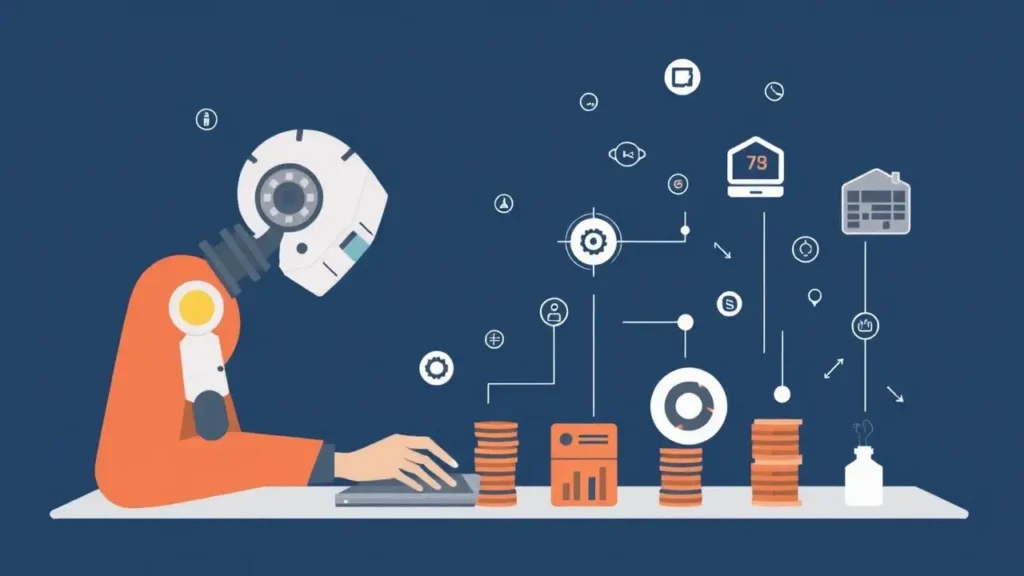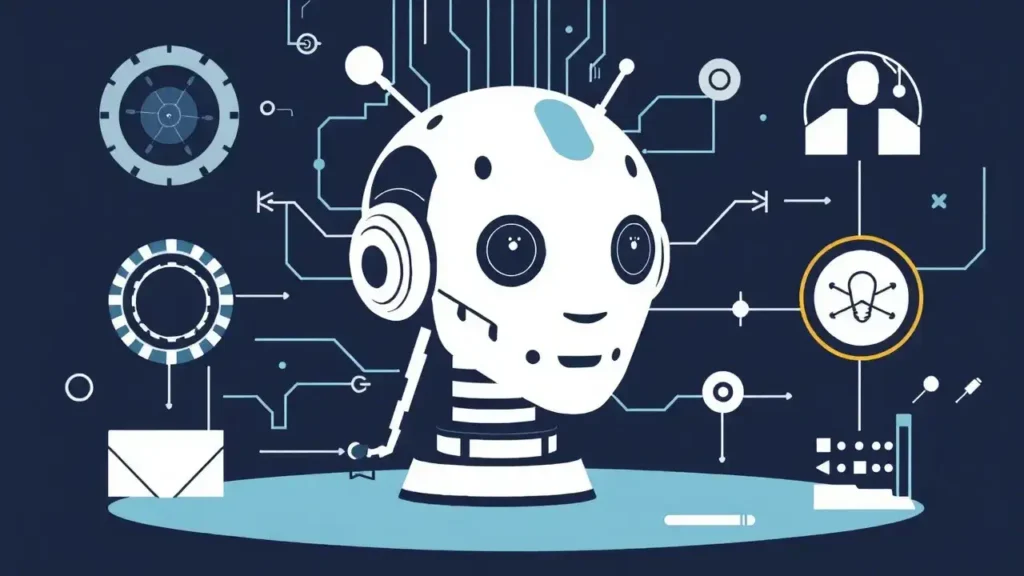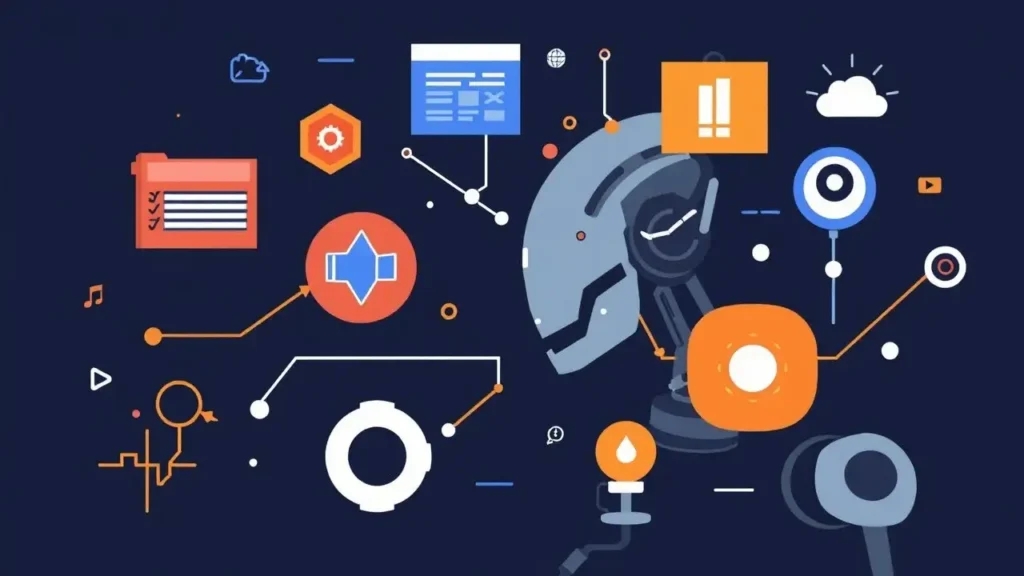AI is no longer just a futuristic concept. It’s here, and it’s transforming how small businesses and entrepreneurs operate daily.
From project management to marketing automation, AI productivity tools bridge the gap between efficiency and scalability, helping companies streamline processes, save valuable time, and amplify results.
If you’re a business owner or tech enthusiast looking to understand the most popular AI tools dominating 2024, you’re in the right place.
This guide explores the tools shaping the productivity landscape, provides real-world examples of their implementation, and offers practical advice on choosing the right one for your specific needs.
Table Of Contents
Understanding AI Productivity Tools

What are AI Productivity Tools?
AI productivity tools are software solutions powered by artificial intelligence that help automate tasks, enhance efficiencies, and optimize workflows for businesses of all sizes.
Whether it’s organizing schedules, analyzing data, or interacting with customers, these tools reduce human effort in repetitive tasks while maintaining accuracy and speed.
Why Are They Important for Small Businesses?
For small businesses and entrepreneurs, AI productivity tools are a game-changer. By automating time-consuming activities like data entry, customer interactions, or lead generation, business owners can focus on strategy and creativity rather than mundane, repetitive work.
Recent statistics back this up—63% of small businesses now report using at least one AI tool in their operations, a significant 15% increase from the previous year (Source: TechJuncture, 2024).
AI isn’t just about saving time—it’s about creating opportunities for growth.
For example, Deloitte’s 2024 study found businesses adopting AI tools in marketing see a 30% hike in conversions and a 60% increase in qualified leads. Imagine what those numbers could mean for your business!
Popular AI Productivity Tools of 2024
AI tools cater to various business needs. Here’s a deeper look at the most sought-after tools segmented by function:
Project Management
AI-enhanced project management tools help you organize, delegate, and monitor progress like never before.
- Monday.com – Powered by AI, Monday.com simplifies team collaboration by predicting bottlenecks, automating task assignments, and offering advanced analytics to ensure projects stay on track.
- Trello AI Assistant – Helps prioritize tasks based on deadlines and workload, suggesting real-time adjustments to calendars and workflows.
Customer Service
AI-powered customer service solutions are changing the game by enhancing user experiences, improving efficiency, and reducing the workload on your team.
These tools ensure faster, more accurate responses to customer inquiries, allowing your team to focus on more complex tasks.
- Ada – Ada is a highly advanced AI chatbot designed to help businesses automate their customer service operations. It enables organizations to respond to customer inquiries 24/7 with personalized and human-like accuracy, all while scaling support without adding extra staff. Ada integrates seamlessly with various platforms, ensuring consistent and reliable service.
- Zendesk AI – Zendesk leverages machine learning-powered insights to help businesses anticipate customer needs and improve resolution times. By analyzing customer behavior and past interactions, Zendesk AI provides actionable insights that empower teams to deliver timely, targeted support. This tool also helps streamline workflows, making it easier to manage high volumes of customer inquiries efficiently.
Data Analysis and Forecasting
Data sits at the core of every sound business decision, but transforming raw data into meaningful insights requires powerful tools.
Artificial Intelligence (AI) revolutionizes this process by enabling faster and more sophisticated data analysis, generating actionable insights that drive better decisions.

Now, with data visualization platforms like Tableau and Microsoft Power BI integrating advanced AI capabilities, businesses can not only view their data but interact with it intelligently to uncover trends, predict outcomes, and foster collaboration across teams.
Tableau with AI – Intelligent Visualization for Deeper Insights
Tableau enhances how businesses approach data visualization by integrating AI-driven capabilities that go beyond static dashboards.
With AI, Tableau makes it easier to identify patterns, spot trends, and provide automatic recommendations—all while enabling teams to create visually compelling, interactive visualizations.
For example, Tableau’s “Explain Data” feature, powered by AI, enables users to understand why a particular data point or trend exists.
Imagine sales are unexpectedly down in a specific quarter—Tableau can analyze the contributing factors in the background, such as customer demographics, product performance, or market activity, and present explanations instantly.
These automatic insights save time and highlight opportunities and problem areas you might otherwise miss.
More importantly, teams can seamlessly share these insights with colleagues for effective collaboration.
Whether you’re reviewing market trends or identifying operational inefficiencies, Tableau empowers businesses to make decisions backed by easy-to-understand, data-rich visuals.
Microsoft Power BI – Predicting the Future with AI
Microsoft Power BI takes business intelligence to the next level. Equipped with cutting-edge AI functionalities, the platform empowers organizations to move from analyzing past data to predicting future outcomes.
Features like predictive analytics and natural language processing allow businesses to anticipate trends and act proactively.
Consider a retail business using Power BI to forecast customer demand during the holiday season. By analyzing historical sales data, regional preferences, and trending market factors, Power BI can predict which products will be in high demand—and even suggest optimal inventory levels to avoid overstocking or understocking.
The platform can also identify emerging customer behaviors by analyzing data from multiple sources, like social media activity and web traffic.
Another standout feature is Power BI’s Q&A functionality. Here, users don’t need to be tech-savvy; simply type or speak queries like:
“What were the total sales last quarter in North America?”
or
“How did product X perform compared to last year?”
AI processes the question and generates a precise, visually engaging report instantly. This democratization of data access empowers teams across departments, allowing non-technical staff to gain data-driven insights without relying heavily on analysts.
The AI Advantage for Teams and Businesses
Both Tableau and Power BI amplify the impact of AI in ways that make data more accessible, actionable, and collaborative.
They help businesses uncover hidden trends, make predictions with confidence, and visualize outcomes in ways that are easier for teams to understand and share.
With AI taking on the heavy lifting of data analysis, organizations can redirect their efforts toward strategy and innovation rather than spending countless hours crunching numbers.

Whether it’s improving customer experiences, optimizing supply chains, or planning future campaigns, AI-powered tools like Tableau and Power BI are transforming how businesses visualize, interpret, and act on data—making better decisions faster and more collaboratively than ever before.
Marketing Automation
Marketing battles are won with targeting, and AI takes personalization to a new level.
- Jasper AI – A revolution in content creation, Jasper generates compelling marketing copy, blog posts, and even social media captions at scale.
- HubSpot AI – Elevates CRM and marketing by analyzing customer data to craft highly targeted campaigns.
No matter your business need—be it customer acquisition, workflow management, or data processing—these tools are reshaping the landscape in 2024.
Real-Life Case Studies of AI Productivity Tools in Action
SkyHigh Digital (Customer Service)
SkyHigh Digital, a small digital marketing agency, implemented Zendesk AI to manage its growing customer inquiries.
Automated messages resolved 65% of tickets without human intervention, improving efficiency and boosting customer satisfaction scores by 40%.
AI transformed how we engage with customers. Our team now spends more time brainstorming creative strategies instead of answering repetitive questions.
SkyHigh’s CEO
EcoStyle Apparel (Marketing)
EcoStyle Apparel, a sustainable clothing brand, adopted Jasper AI to scale its social media presence. With Jasper’s AI-generated posts, EcoStyle increased engagement rates by 50% within three months while reducing the team’s workload by 30%.
How to Choose the Right AI Productivity Tool
Selecting the right one of the best AI productivity tools can feel overwhelming with so many options out there. Here’s a checklist to guide your decision:
- Define Your Key Needs – What problem do you need to solve? Whether it’s faster report generation or better customer service, clarity is crucial.
- Test User-Friendly Interfaces – The best tools simplify processes, not complicate them. Choose software your team can learn and use easily.
- Budget Considerations – AI tools range from free versions to premium plans. Compare costs against the ROI you’ll get.
- Scalability – Your tool should be able to grow as your business does.
- Look for Integrations – Ensure the tool integrates seamlessly with existing software like Slack, Zapier, or your CRM.
Future Trends in AI Productivity Tools
The AI landscape is constantly evolving, and exciting trends are shaping the future of productivity tools. Here’s what’s on the horizon:
- Generative AI Growth – Tools like ChatGPT are transforming the way content is created, enabling businesses to generate unique, high-quality text, images, and even code in seconds. Generative AI is set to expand further, offering more sophisticated and customizable outputs across industries.
- Hyper-Personalization – AI will increasingly analyze real-time behavioral data to deliver highly tailored, user-specific experiences. From personalized marketing campaigns to adaptive learning platforms, businesses will be able to connect with their audiences on a deeper and more meaningful level.
- Voice-Powered AI – The adoption of voice-controlled tools, like virtual assistants and automated transcription services, is expected to grow significantly. This hands-free approach to productivity will be particularly useful for multitasking professionals and industries that rely on verbal communication, such as healthcare and customer service.
- Sustainability Integration – As businesses prioritize eco-friendly practices, AI tools will play a key role in aligning productivity with sustainability. Future tools may help companies optimize workflows to reduce energy consumption, minimize waste, and adopt greener operational strategies.
According to Forrester, the AI software market is projected to reach $37 billion by 2025, with much of this growth driven by small and medium-sized businesses eager to leverage AI’s potential.
Staying ahead of these trends will give your business a crucial edge, enabling you to innovate, optimize, and thrive in the ever-evolving marketplace.
Find the Right Fit for Your Business Today
AI productivity tools are more than a trend—they’re a necessity to stay competitive in a rapidly evolving business landscape.
Whether you’re running a two-person startup or a thriving small business, the right AI tools can elevate your performance to new levels.
Think it’s time to explore your options? Start with a free trial of tools like Jasper AI or Tableau to see what they can do for your business. By stepping into the AI era, you’re not just keeping up; you’re leading the way.
FAQ About AI Productivity Tools
1. What are AI productivity tools?
AI productivity tools are software powered by artificial intelligence designed to help you work smarter.
They assist with tasks like scheduling, data analysis, content creation, project management, and automating repetitive processes, saving time and allowing teams to focus on priorities.
2. How can AI productivity tools improve my workflow?
AI productivity tools streamline workflows by automating routine tasks, providing real-time insights, and enhancing collaboration. For example:
- Automating email responses.
- Generating data-driven reports in seconds.
- Drafting or editing content with improved accuracy.
3. Do AI productivity tools require technical expertise?
Most AI productivity tools are user-friendly and don’t need advanced technical skills. They usually have simple interfaces, guided setups, and tutorials. If you run into issues, many platforms offer support teams or help centers.
4. Are AI productivity tools secure?
Reputable AI productivity tools prioritize security and use strong encryption to protect your data. Choose tools that comply with standards like GDPR and review their privacy policy and security features before using them.
5. Can AI tools integrate with other software I use?
Yes, many AI platforms integrate with AI productivity tools like Google Workspace, Microsoft Office, Slack, and project management systems. This ensures smoother workflows without constantly switching between apps.










